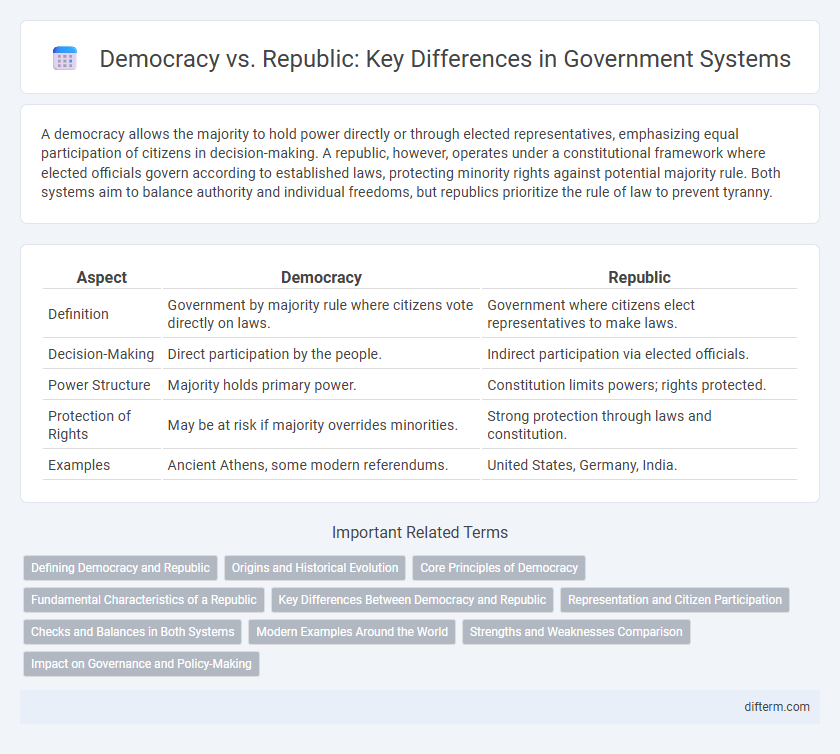A democracy allows the majority to hold power directly or through elected representatives, emphasizing equal participation of citizens in decision-making. A republic, however, operates under a constitutional framework where elected officials govern according to established laws, protecting minority rights against potential majority rule. Both systems aim to balance authority and individual freedoms, but republics prioritize the rule of law to prevent tyranny.
Table of Comparison
| Aspect | Democracy | Republic |
|---|---|---|
| Definition | Government by majority rule where citizens vote directly on laws. | Government where citizens elect representatives to make laws. |
| Decision-Making | Direct participation by the people. | Indirect participation via elected officials. |
| Power Structure | Majority holds primary power. | Constitution limits powers; rights protected. |
| Protection of Rights | May be at risk if majority overrides minorities. | Strong protection through laws and constitution. |
| Examples | Ancient Athens, some modern referendums. | United States, Germany, India. |
Defining Democracy and Republic
Democracy is a system of government where power is vested in the people, who exercise that power directly or through elected representatives. A republic is a form of government where the country is considered a public matter, and officials are elected as representatives of the people, emphasizing the rule of law and a constitution. Both systems prioritize citizen participation but differ in mechanisms of governance and legal frameworks.
Origins and Historical Evolution
Democracy originates from ancient Greece, specifically Athens in the 5th century BCE, where direct citizen participation shaped decision-making processes. The concept of a Republic traces back to ancient Rome, emphasizing elected representatives and a codified constitution to balance power among branches of government. Over centuries, modern democracies and republics evolved, blending direct citizen involvement with representative governance to address the complexities of growing populations and states.
Core Principles of Democracy
Democracy centers on the core principles of popular sovereignty, political equality, and majority rule, ensuring that all eligible citizens have the right to participate in decision-making processes. Transparency and accountability are fundamental, promoting government responsiveness to the public and safeguarding civil liberties such as freedom of speech and assembly. Unlike a republic, where a constitution limits government powers and protects minority rights, a democracy emphasizes direct participation and collective consensus.
Fundamental Characteristics of a Republic
A republic is characterized by the rule of law, where elected representatives govern according to a constitution that limits their powers. It emphasizes the protection of individual rights and the separation of powers among branches of government to prevent tyranny. Unlike direct democracy, a republic allows citizens to elect officials who make decisions on their behalf, ensuring a balanced and stable political system.
Key Differences Between Democracy and Republic
Democracy operates under the principle of majority rule, where decisions are made directly by the people or through elected representatives, emphasizing equal participation. A Republic, however, is characterized by a constitution that protects individual rights and limits government power, ensuring that elected officials govern according to established laws. Key differences include the direct vs. representative decision-making process and the presence of constitutional safeguards in republics that prevent majority tyranny.
Representation and Citizen Participation
Democracy emphasizes direct citizen participation in decision-making, allowing individuals to vote on laws and policies themselves. In contrast, a republic relies on elected representatives to make governance decisions on behalf of the citizens, ensuring a structured system of accountability and rule of law. This distinction affects how power is distributed and how citizens influence government actions within these political frameworks.
Checks and Balances in Both Systems
Both democracy and republic systems implement checks and balances to prevent the concentration of power and protect individual rights. In a republic, elected representatives govern under a constitution that limits government actions, ensuring separation of powers among executive, legislative, and judicial branches. Democratic systems emphasize direct participation or majority rule, but often incorporate institutional checks such as courts or bicameral legislatures to balance majority influence and safeguard minority rights.
Modern Examples Around the World
Modern democracies like Sweden and Canada emphasize direct citizen participation through regular elections and referenda, ensuring government accountability and transparency. Republics such as the United States and India operate with elected representatives who exercise power within a framework of constitutional law, balancing majority rule with the protection of minority rights. Both systems adapt to contemporary challenges by promoting civic engagement and institutional checks to uphold democratic principles globally.
Strengths and Weaknesses Comparison
Democracy emphasizes direct participation and majority rule, promoting inclusiveness and responsiveness but risks populism and majority tyranny. Republics rely on elected representatives and constitutional frameworks, ensuring stability and protection of minority rights yet may face challenges with political polarization and slower decision-making. Both systems balance power distribution differently, impacting governance effectiveness and citizen involvement.
Impact on Governance and Policy-Making
Democracy emphasizes direct participation of citizens in governance, leading to policies that closely reflect public opinion and potentially result in more frequent policy shifts based on majority preferences. Republics operate through elected representatives who make decisions on behalf of the populace, often fostering stability and long-term policy planning by balancing majority rule with constitutional constraints. This distinction shapes governance by influencing how responsive governments are to public demands and how effectively they manage diverse interests within the political system.
Democracy vs Republic Infographic

 difterm.com
difterm.com